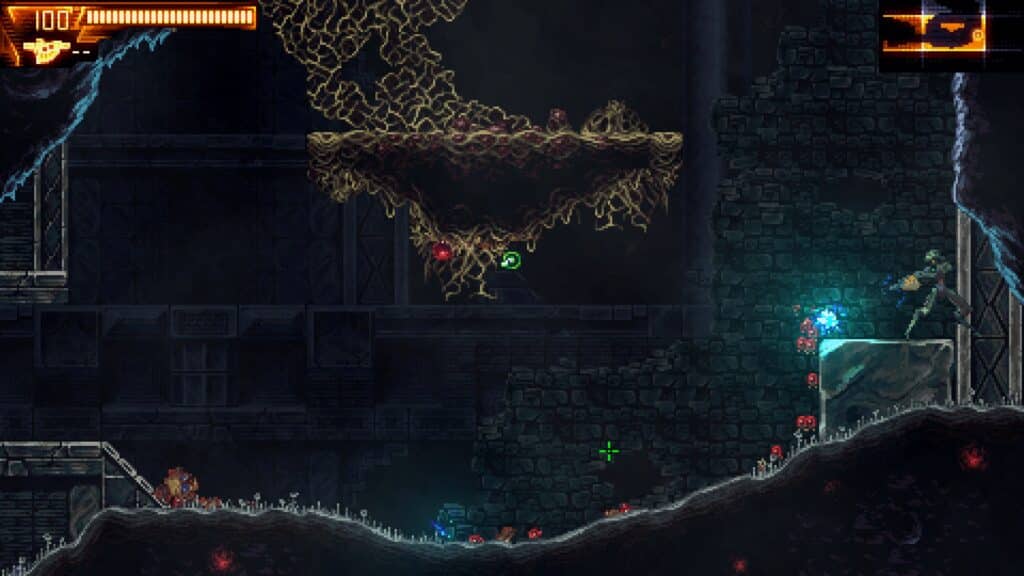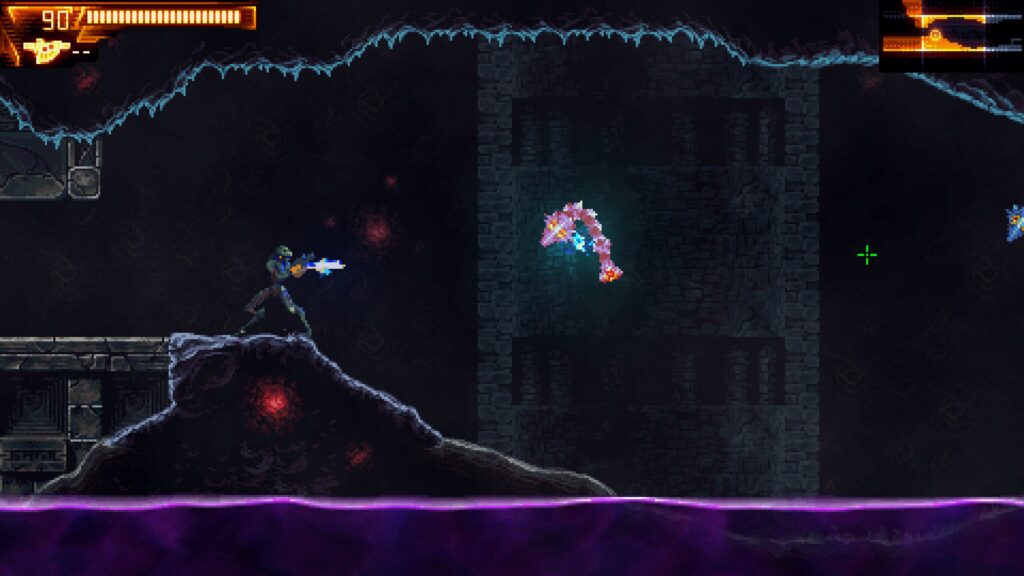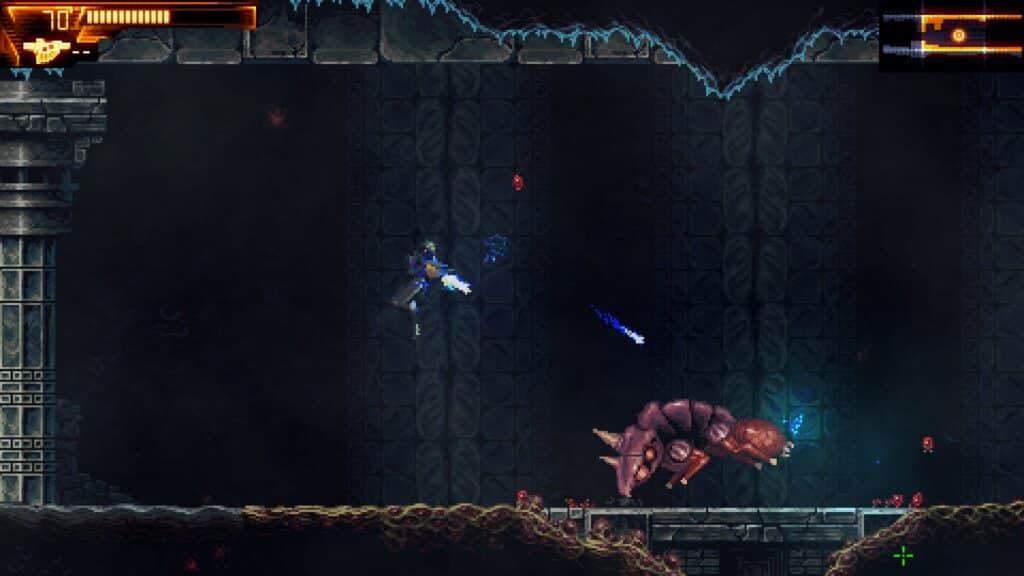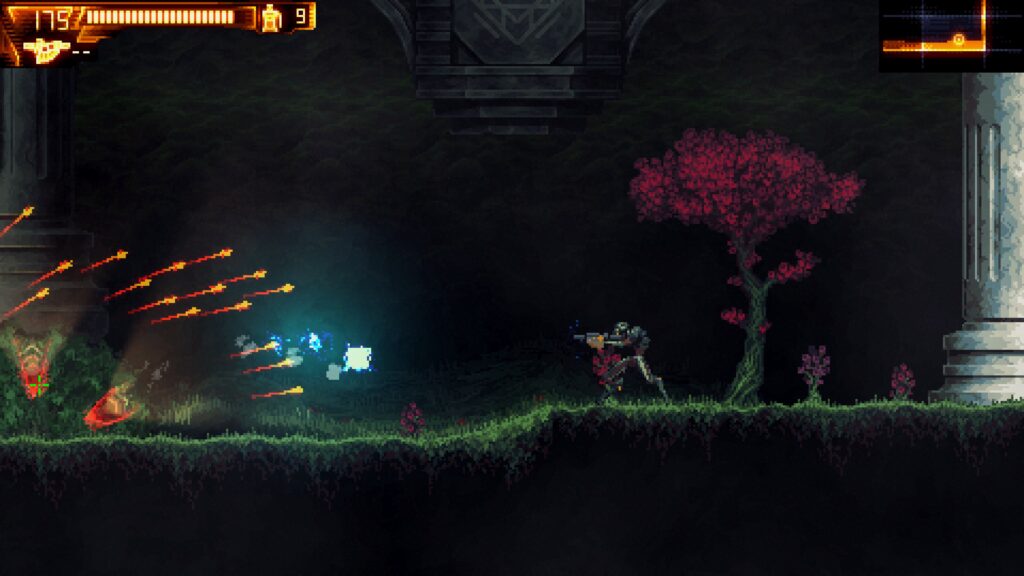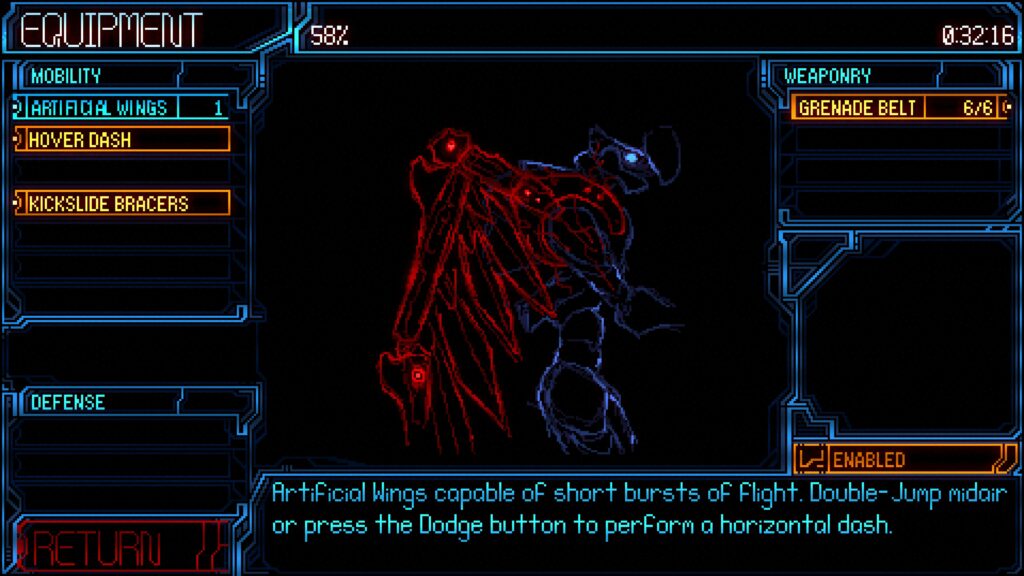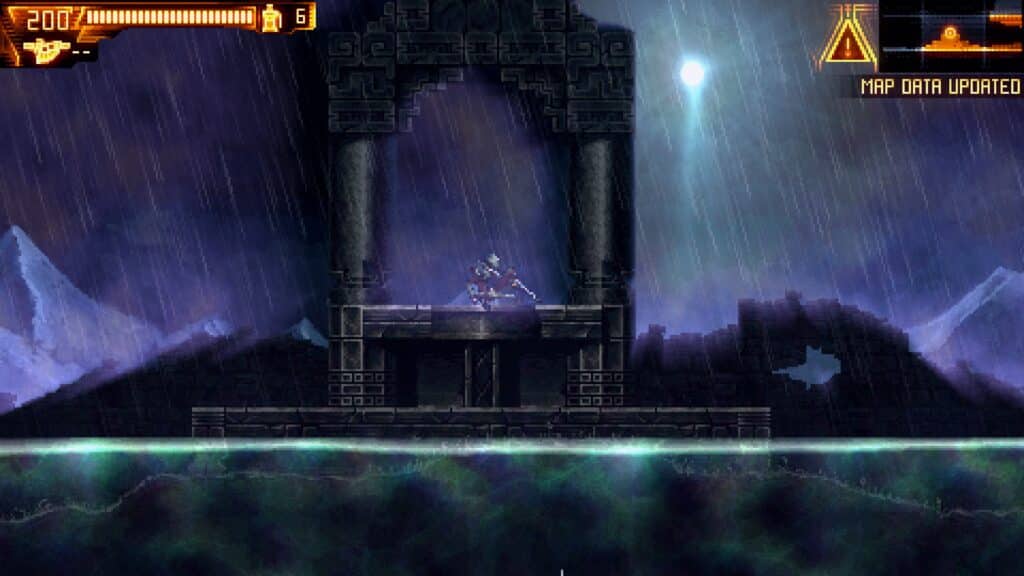Acrolyte is a 2D Metroidvania set in a world seemingly devoid of intelligent life. We play as a bio-mechanical being that, for reasons unknown, has awakened from a deep slumber. There is no text or exposition here. It’s up to us to make sense of these alien surroundings and push forth past all the hostile creatures inhabiting them. Whatever our character is, he is not defenseless. He woke up wielding a semi-automatic pistol with infinite ammo and is not shy to use it against our mostly organic foes. Shooting, moving, and jumping are the extent of what we can do starting off. It teaches the player how vital aiming is, as most of our initial enemies are tiny in stature. Underestimate them, and you may find yourself panic-firing into a swarm of what I can only call wasps from hell.
This is not an easy demo. Your basic enemy mob is not your most significant threat, yet they can still wither you down via attrition as you pray for a save point soon. It’s all too easy to find yourself spacing off while admiring the scenery; all the while, a pint-sized fiend is getting ready to pounce on you from a distance. Acrolyte’s pixel art and artistic direction are stunning. Right from the get-go, it impresses with a view of our character sleeping in blue flames while surrounded by water casting off a mystical hue. This is an unfamiliar world. While seeming quite grim, it is not afraid to throw in colorful scenery. With how mechanical we are compared to most things, our character nearly looks like the invader here. The lack of a story offers interesting possibilities to ponder on when you’re not in combat.
Aside from the base pistol, we can find a Shock Gun later on. It shoots a slow-moving ball of electricity that damages any enemy in its path. The devs pulled off a neat trick here. In the first boss fight you get it in, using the Shock Gun feels outright overpowered. What was once a battle where you dared not even blink became so one-sided it nearly felt like cheating. The upcoming boss will change your perception of it real quick. In Acrolyte, projectiles can be shot out of the air, including your own. That big ball of death becomes a liability if not used thoughtfully when you’re being pelted by enemy fire. It’s essentially a floating balloon that takes skill to use correctly rather than the “I win” weapon it first appeared to be. You will have to switch weapons occasionally, and by that point, we’ve unlocked additional movement options and grenades to toss. The gameplay has depth that may not be apparent from the screenshots alone.
All of the enemies gib upon death. If you’re unfamiliar with that term, it’s a way of saying they’ll explode into meaty chunks when slain. This adds to the weight of the combat, even if the Pistol’s sound effect is a bit underwhelming. Each chunk also contains physics. That allows the viscera to bounce off the surroundings and roll around on uneven ground. Acrolyte features subtle effects, including bullet trails when firing into the water. Small details like that help the world feel alive. The only visual element I disliked was that of the temporary weapon. It is comically oversized. While it looks awesome in the key art, the translation into sprite work could use some tweaking. This Assault Rifle has limited ammo, like every weapon that isn’t the Pistol. It is best used sparingly. Amusingly enough, we can also throw it at enemies to cause some damage. This is a viable tactic to save this short-lived firepower for later.
The level design is solid, and the backgrounds have a fair amount of variety. Even without glancing at the in-game map, it invisibly guides the player well. In true Metroidvania fashion, much of the branching paths will require an ability to pass, be it grenades or kick sliding. Exploration is particularly rewarding in this title due to its challenging nature. If you are getting slammed in a boss fight, backtracking to increase your overall health or grenade slots can make all the difference. A minor nitpick here is how zoomed in the map is. It requires too much dragging around with your mouse to find unexplored areas. That nitpick will grow as the game’s world expands in future versions, so hopefully, a clearer overview of our available paths is planned. According to the in-game stats, it took me nearly 40 minutes to reach the end of the demo. I’d wager it’s closer to an hour since I died a few times, and that restarts you at the last save point. That doesn’t include the time spent exploring everything I’ve missed after reaching the end. This is a meaty demo.
Most of the music is a combination of ambient sounds and synth. The centerpiece of it is the sound of air whirring by as if the caves you’re exploring are alive. There are some faint synth notes to spice things up, though the focus remains on the atmosphere. Until you reach a boss fight. That’s where the Drum and Bass music genre kicks up, as does my volume slider. It’s a shame that every boss currently shares the same track, yet the song remains an absolute bop until the end. The stark contrast between having moody music for exploration and high-energy tunes as you face off against deadly foes works well. After defeating them, you get a journal entry with a brief snippet of lore of what they are. The same goes for any basic enemy that you defeated or ability gained, such as the double jump. The lore in the Logbook is shaping up to be quite expansive, judging by how many sections and entry slots are found within.
Regarding the technical side of things, I’ve experienced no glitches or crashes. When I first booted the title up, it displayed in a window with massive black borders surrounding the game. I imagine that was the pixel-perfect mode for the sprite work. For pictures in this article, I used the fullscreen option. The graphics I’m presenting may be less sharp than intended. Acrolyte runs at an unlocked frame rate and has a handy frame limiter built into the options menu. The fact that it doesn’t have an arbitrary limit to the FPS is always a plus, as it lets customers make full use of their monitor or TV if it’s capable of over 60hz. I briefly played on an old laptop with integrated graphics, and it ran fine. If you’re having trouble running it, there are options to lower the lighting and fog quality. As I don’t have access to a Steam Deck, I’m not sure if this demo can run on its OS. Given the current lack of controller support, it would be less than optimal unless you have a proper keyboard and mouse set up for that portable device.
At the end of the day, Acrolyte certainly impressed. This alien and hostile world is shaping up to be a memorable one. One of the most stand-out features for me was the need for precision. Many of the creatures have hardened exoskeletons with only narrow openings for our weapons to have an effect. Knowing when to shoot and reposition lends it a different feel than your typical Run n’ Gun title. It is a challenging demo, even if the current ammo balance ensures we are always flush with bullets. Each boss did more than enough to check any ego we may be developing and were always a blast to fight. The demo is very much worth playing if you’re up for an afternoon of action-packed exploration. Acrolyte has an hour’s worth of content to convince us to wishlist the game and to keep an eye out for its full release. With its small 58MB download size, it’s difficult for us Metroidvania fans who enjoy a challenge not to take it up on its offer and see what all the fuss is about.
- Acrolyte Demo - April 11, 2025
- Lostaris Demo - April 4, 2025
- El Panadero -The Baker- Review - August 27, 2024
